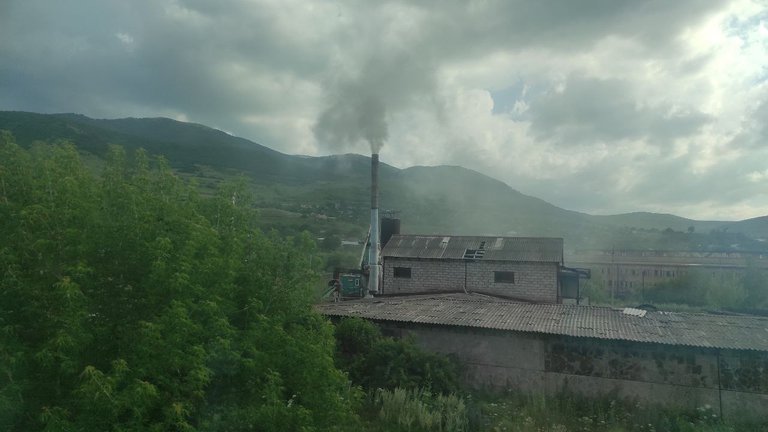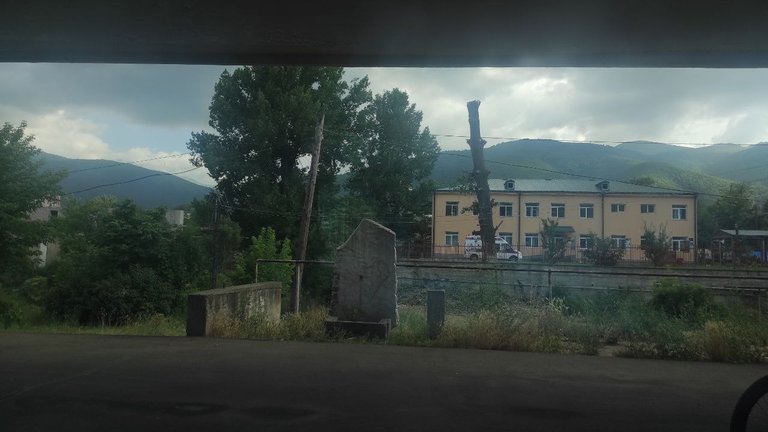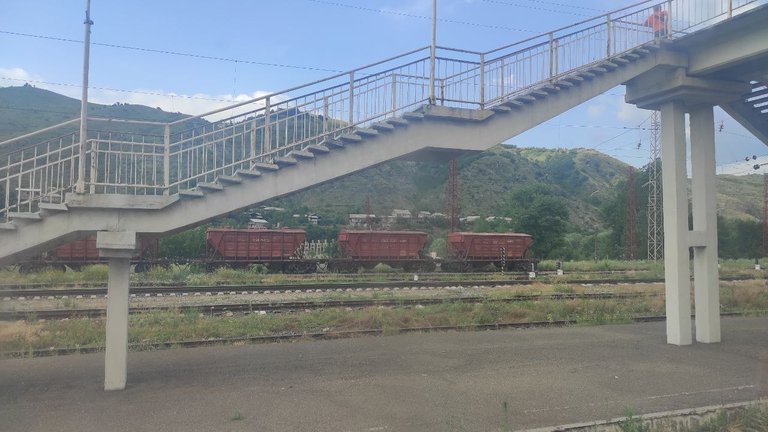
It has taken me a while to think of how to go about finishing this little series of mine in which I took the sleeper train from Yerevan, Armenia to Tbilisi, Georgia. That may sound a bit odd, but I have been met with the problem of how to go about uploading the final images. See, they aren't really final images, but videos. I reached a point during my sleeper train experience in which my sheer admiration for the views around me led to pretty much shutting down everything and just sitting there with me spending the rest of the remaining sunlight just looking out into the vastness of the natural world. The density of the trees that swallowed up the mountains, and even some of the tracks. The harshness of nature that had left massive destruction in its path in the form of recent floods, destroying old buildings and villages in the process. The debris still visible, and the recent desperation to maintain some infrastructure present in how they had rebuilt the bank in which the train rail sat on. Some areas had been destroyed entirely. The train would come to a near stop and we'd be travelling over rail that is clearly temporal. Bumpy and jolting us all around. To look out of the window in such moments is to realise how unsafe all of this was growing, the more we pushed forward.
Changes to the terrain would have us twisting and turning around on old bridges in which you could see their wooden architectural frames. As the train would turn with the track, views of the Soviet Unions former industrial empire would come into view, no longer small farms and villages, but attempts to bring life to places where civilisation as we knew it simply didn't exist. It was odd to be surrounded by strong edges of mountains, ragged cliff-edges and dense forestry, for sudden grand architectural designs that were shaped like palaces to come into view. This was an environment that simply didn't make sense. These buildings would be massive. Not always ones of industry, some would have a clear structure that spoke of their factory purposes, others would just be huge and it'd be hard to understand just what their intended purpose was. Looking more like huge offices rather than homes or anything else. Still incredibly old, still holding that traditional Armenian style with its patchy brickwork. There were so many moments from this point on that I wish the train would just stop, to state that there's some kind of delay or issue and we'd have to remain in these locations for a few hours. As annoying as that would've been, the freedom to roam these places would've meant so much to me.

With the sheer quantity of trees in such areas, and the rocky landscape of it all, these destinations almost didn't seem real. As if for theatre for those passing through. This wasn't the case, of course. But what I mean by that is the buildings that would suddenly come into view seemed almost impossible to get to, hard to imagine the route people take to navigate such an area, to which it'd definitely be a weaving between trees and the landscape in order to get up to those areas. Trees obscuring the paths they would take. I say paths because it was clear that in many of these areas, there were no roads. No definite way to get through by car. This was almost a little more evident in the number of small mopeds and bicycles that were seen around near the few stations we'd cross. The children would still continue to wave, to run alongside the train, some would attempt to race it, riding as fast as they could until the station ran out of space and we moved on out of the area. Locals there seemed aged, a dying breed. A group that seemed to be the final generation with many stories to tell. Hard-worked, tired, and a little bit roughed-up from a clear sign of decades of poverty. Reused clothing, dated with muted colours.

I had previously seen how such people lived with my first visit to Georgia: an Armenian village that was located near the border, now within the Georgian land despite many of these border villages being entirely and historically Armenian. A van would bring clothes stacked to the villages, owned by locals as well. Their own fashion reduced to whatever they could find and kept them warm under the freezing cold. The brands varied, from old to more modern clothing. Whatever they could get their hands on. Locals would spend their time going through the options and either barter with fresh produce or trade with cash. I suspected the same took place in these areas. People wore what was not only comfortable, but what they could get. These people didn't look tormented, however. They didn't look to be suffering. But simply led a life totally different. They still smiled, still interacted with each other with the small communities they had. And again: my want to simply stop the train and get off to talk to them and hear their stories was starting to peak at this point. My curiosity over the life here had me with such interest that I told myself that one day, I will return. Specifically to come to these areas. Just to speak to the locals, perhaps document it. To spread their stories and capture what could be the last generations that live within these areas.

We passed through a town of the name Vanadzor. An industrial town that holds a truly massive chemical production plant. I can't stress just how large this plant was. I have never seen anything like it before. The whole thing completely blew me away in its scale. And this was the main place that I truly wished I could've hopped off the train and walked around. Such a flat small town but coated in trees, surrounded by mountains. The view from the train was a huge series of structures, massive towers. The colour black was intense. I had no idea if any of this was still active. This was a location that was clearly built by the Soviets. And I read that not too long ago Armenia wanted to revive the plant (I'm not sure if it did in the end) and pay its workers a whopping $200 per month. Insane. This location was so tucked away, so hidden away in the depths of the mountains. Nothing else to do here. Nothing for those who remain. The housing was clearly made for those who worked at the plant. A common case of these industrial towns that were made purely for one thing, and once the Union collapsed there was nothing left for those people, now having to figure things out on their own. A struggle with no supply nor any demand in the space. In some poetic manner, after the train took a few minutes of a break here, it proceeded on with the travels. And the sun began to set. The last of Armenia I saw was the beauty and time-tormented Vanadzor.
Congratulations, your post has been added to the TravelFeed Map! 🎉🥳🌴
Did you know you have your own profile map?
And every post has their own map too!
Want to have your post on the map too?
- Go to TravelFeed Map
- Click the create pin button
- Drag the marker to where your post should be. Zoom in if needed or use the search bar (top right).
- Copy and paste the generated code in your post (any Hive frontend)
- Or login with Hive Keychain or Hivesigner and click "create post" to post to Hive directly from TravelFeed
- Congrats, your post is now on the map!
PS: You can import your previous Pinmapple posts to the TravelFeed map.Opt Out
Congratulations, your post has been added to WorldMapPin! 🎉
Did you know you have your own profile map?
And every post has their own map too!
Want to have your post on the map too?
Congratulations @namiks! You received the biggest smile and some love from TravelFeed! Keep up the amazing blog. 😍 Your post was also chosen as top pick of the day and is now featured on the TravelFeed front page.
Thanks for using TravelFeed!
@for91days (TravelFeed team)
PS: TravelFeed is in social media to reach more people, follow us on Facebook, Instagram, and X.